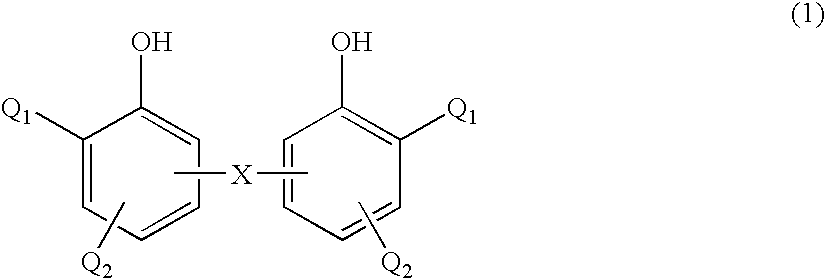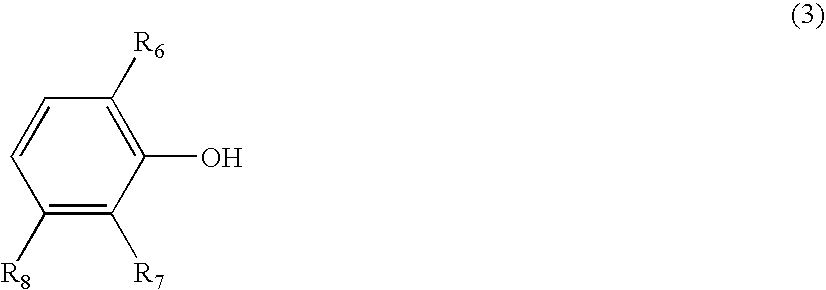Low molecular weight polyphenylene ether
- Summary
- Abstract
- Description
- Claims
- Application Information
AI Technical Summary
Benefits of technology
Problems solved by technology
Method used
Image
Examples
example 1
In a 1.5-L jacketed reactor equipped with a sparger to introduce an oxygen-containing gas, a stirring turbine blade and a baffle, each at the bottom of the reactor, and a reflux condenser in a vent gas line at the upper portion of the reactor, 0.2512 g of cupric chloride dihydrate, 1.1062 g of 35% hydrochloric acid, 3.6179 g of di-n-butylamine, 9.5937 g of N,N,N′,N′-tetramethylpropanediamine, 211.63 g of methanol, 493.80 g of n-butanol and 180.0 g of 2,6-dimethylphenol were charged. The weight ratio of each solvent component was n-butanol / methanol=70 / 30. Under vigorous stirring, the introduction of oxygen from the sparger was started at a rate of 180 ml / min. At the same time, the polymerization temperature was adjusted and kept at 40° C. by introducing a heating medium in the jacket. The polymer solution became a slurry in progression. No adhesion was observed on the reactor during the polymerization. 120 minutes later from the initiation of oxygen introduction, the introduction of...
example 2
The same method as in Example 1 was repeated except that the weight ratio of each component was changed to n-butanol / methanol=30 / 70. No adhesion was observed on the reactor during the polymerization. The mean particle size of the resultant polyphenylene ether was 34 μm, and no particles larger than 1000 μm existed. Each measurement was carried out in the same manner as in Example 1. The results are shown in Table 1.
example 3
The same method as in -Example 1 was repeated except that the weight ratio of each component was changed to n-butanol / methanol=10 / 90. No adhesion was observed on the reactor during the polymerization. The mean particle size of the resultant polyphenylene ether was 39 μm, and no-particles larger than 1000 μm existed. Each measurement was carried out in the same manner as in Example 1. The results are shown in Table 1.
PUM
| Property | Measurement | Unit |
|---|---|---|
| Temperature | aaaaa | aaaaa |
| Temperature | aaaaa | aaaaa |
| Density | aaaaa | aaaaa |
Abstract
Description
Claims
Application Information
 Login to View More
Login to View More - R&D
- Intellectual Property
- Life Sciences
- Materials
- Tech Scout
- Unparalleled Data Quality
- Higher Quality Content
- 60% Fewer Hallucinations
Browse by: Latest US Patents, China's latest patents, Technical Efficacy Thesaurus, Application Domain, Technology Topic, Popular Technical Reports.
© 2025 PatSnap. All rights reserved.Legal|Privacy policy|Modern Slavery Act Transparency Statement|Sitemap|About US| Contact US: help@patsnap.com



